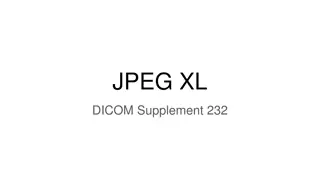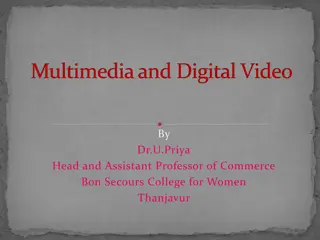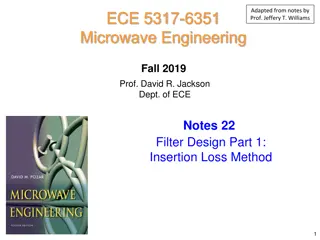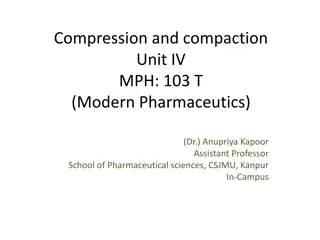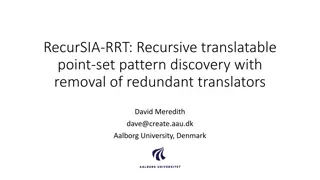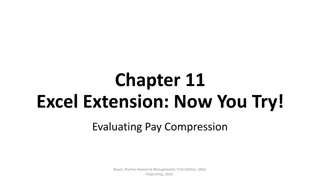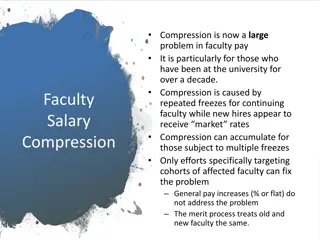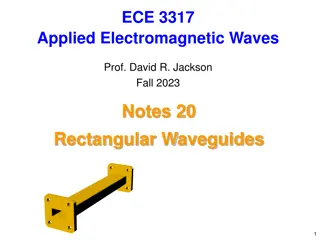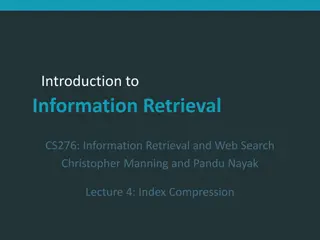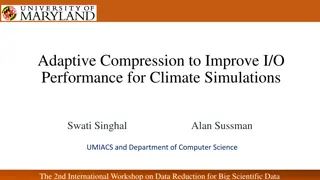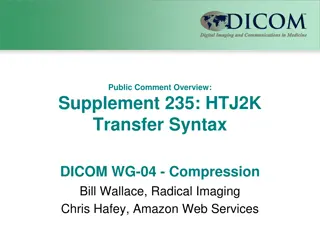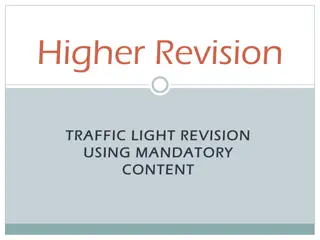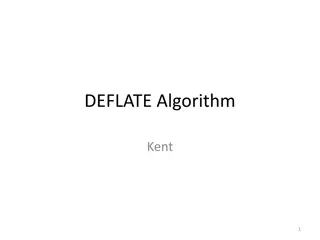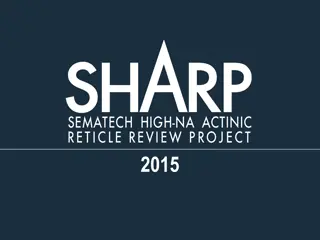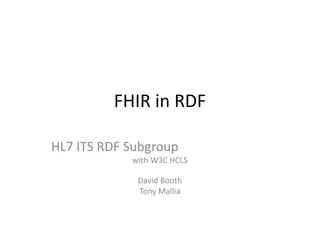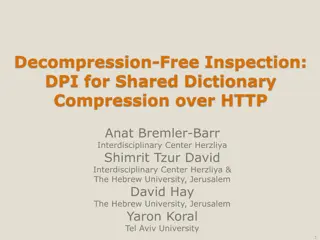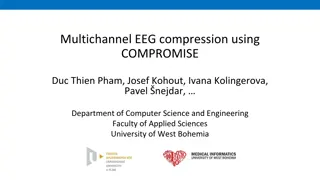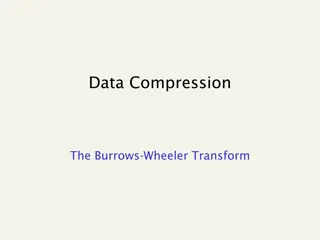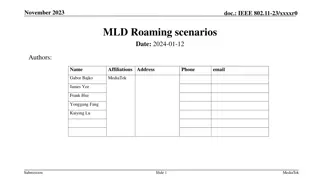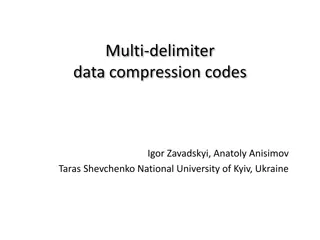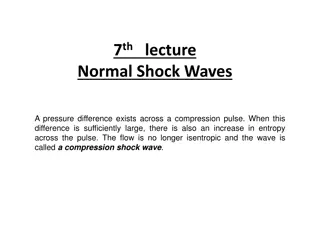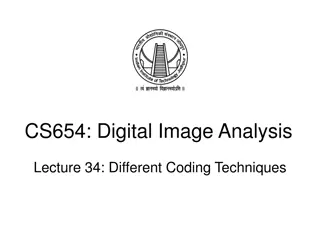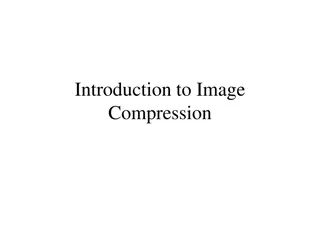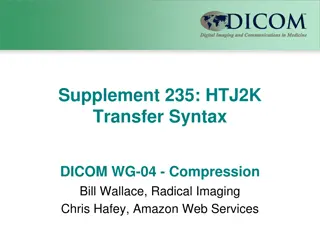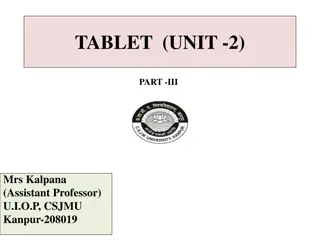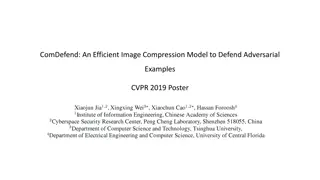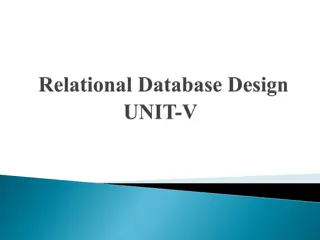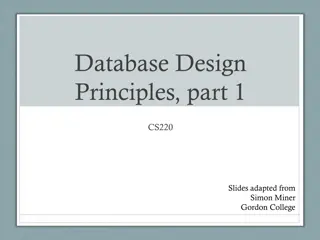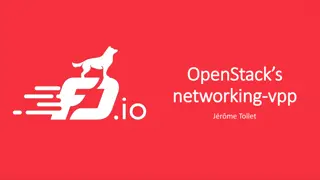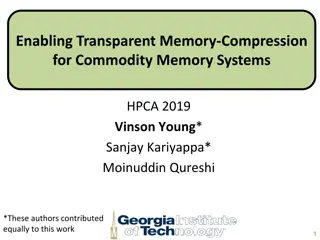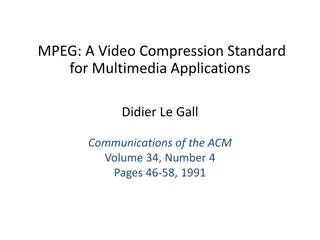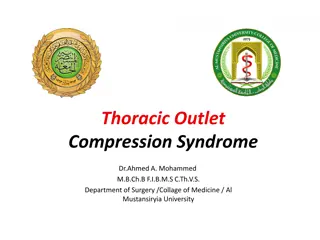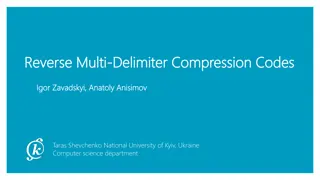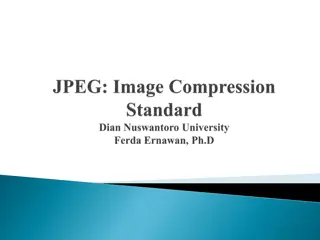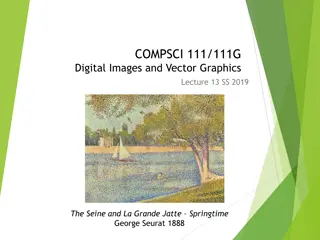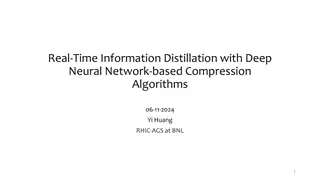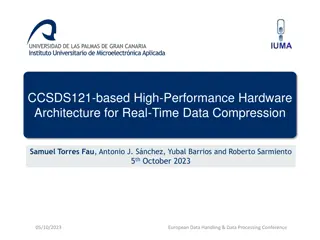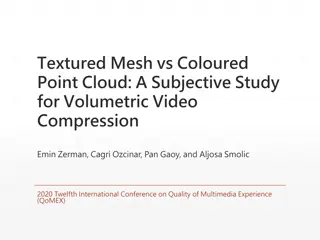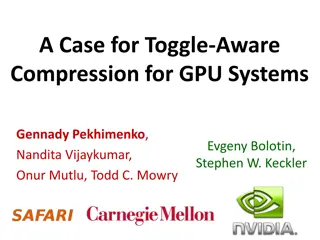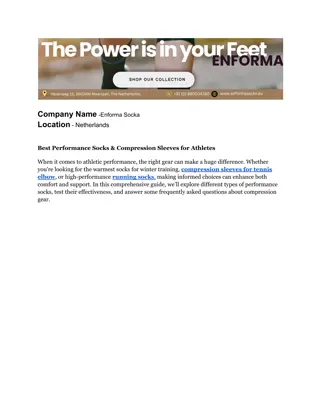Advantages and Challenges of JPEG XL in Whole Slide Imaging (WSI)
JPEG XL offers significantly smaller images for WSI with lossy compression accepted by regulators, supporting >8-bit compression and safe migration from existing JPEG. However, challenges exist such as lack of universal browser support and potential impact on CAD AI. Mayo's limited testing shows pro
0 views • 6 slides
Multimedia and Digital Video Concepts
Explore the world of multimedia and digital video through this informative content. Learn about the meaning of multimedia, stages of transport in multimedia, key concepts, compression methods, data compression in action, and compression techniques. Discover how multimedia combines text, audio, and i
1 views • 51 slides
Microwave Filter Design: Understanding Insertion Loss Methods
Study microwave filter design focusing on insertion loss method for lossless filters. Explore transmission line connections, power loss ratio calculations, and insertion loss in designing filters for specific responses like low-pass. Learn about common filter types and approaches for designing vario
1 views • 35 slides
Tablet Compression and Compaction in Modern Pharmaceutics
This educational material delves into the physics of tablet making, focusing on the forces involved, compaction profiles, and effects of friction. Students will gain knowledge about tablet compression, compaction, and consolidation, including the types of forces at play and the distribution of force
2 views • 16 slides
Compression-Driven Point Set Pattern Discovery in Music
Compression-driven point set pattern discovery in music explores the principle of parsimony in data representation. By applying compression-based algorithms, researchers aim to simplify the description of musical data, leading to better performance in tasks such as classification of folk songs, simu
0 views • 12 slides
Excel Tutorial: Evaluating Pay Compression with Compa-Ratios
Learn how to evaluate pay compression using compa-ratios and tenure data in Excel. The tutorial guides you through calculating compa-ratios for customer service representatives, comparing actual pay to the pay range midpoint, and identifying potential pay compression issues.
0 views • 23 slides
Addressing Faculty Salary Compression Issues in Higher Education
Faculty salary compression has become a significant challenge in higher education, particularly affecting long-serving faculty members. This issue arises from repeated freezes on the salaries of existing faculty while new hires receive higher market rates. General pay increases and merit processes d
1 views • 6 slides
Rectangular Waveguides: Modes and Solutions
Exploring the characteristics of rectangular waveguides, this study delves into the absence of the TEMz mode, the existence of TMz and TEz modes, and the method of separation of variables for solving electromagnetic field equations. The analysis includes the concept of cutoff frequency in lossless w
3 views • 46 slides
Introduction to Information Retrieval: Compression Techniques and Index Optimization
Exploring concepts from information retrieval, this content delves into index compression methods such as blocked sort-based indexing and single-pass in-memory indexing. It discusses the importance of compression for inverted indexes to optimize memory usage and decrease disk space requirements, ult
4 views • 50 slides
Enhancing I/O Performance Through Adaptive Data Compression in Climate Simulations
This research focuses on improving I/O performance for climate simulations by employing adaptive data compression techniques. Scientific data compression methods, such as lossy and lossless compression, are explored to reduce data volume and increase effective I/O bandwidth. The study highlights the
0 views • 18 slides
Improved Imaging Compression with HTJ2K Transfer Syntax
Challenges with existing compression methods like JPEG 2000 have led to the development of High Throughput JPEG 2000 (HTJ2K), offering faster decoding speeds and support for advanced features like scalable resolution. HTJ2K resolves issues related to complexity, patent conflicts, and lack of open-so
0 views • 6 slides
Data Storage and Compression Techniques
Explore various concepts related to data storage and compression, including higher revision techniques, watch points for debugging, RAID disk mirroring, media compression methods, mantissa and exponent representation, and the impact of precision/range adjustments in numerical calculations. Learn abo
0 views • 13 slides
DEFLATE Algorithm: LZ77, Huffman Coding, Compression
DEFLATE algorithm, developed by Kent, combines LZ77 compression with Huffman coding. LZ77 algorithm compresses data using a sliding window technique, while Huffman coding assigns variable-size codewords to characters based on frequency. This process enables efficient data compression and decompressi
0 views • 12 slides
Advanced Microscopy Techniques in EUV Lithography: SHARP Overview
SHARP utilizes Fresnel zone plate lenses to achieve diffraction-limited quality in EUV lithography, offering a range of NA values and image magnifications. The system allows emulation of mask-side imaging conditions with hundreds of lenses available. Coherence control and engineering are provided th
2 views • 18 slides
FHIR in RDF: Requirements for Ontology Mapping and Semantic Representation
Define lossless bi-directional transformations, complete FHIR coverage, enforce constraints, enable inference, and ensure RDF quality in representing FHIR resource instances. Support vocabulary bindings, annotation information, and datatype IRIs while ensuring auto-generatability of mappings.
0 views • 5 slides
Dictionary Compression and Deep Packet Inspection (DPI) Overview
This content discusses Decompression-Free Inspection (DPI) for shared dictionary compression over HTTP, the challenges and solutions in deep packet inspection (DPI), compressed HTTP methods, examples of intra-response and inter-response compression, and current operations of Network Intrusion Detect
0 views • 33 slides
Multichannel EEG Compression Using COMPROMISE Study
A study on multichannel EEG compression using COMPROMISE by Duc Thien Pham, Josef Kohout, Ivana Kolingerova, Pavel Nejdar from the Department of Computer Science and Engineering, Faculty of Applied Sciences, University of West Bohemia. The study covers datasets, methods, and discussions related to E
0 views • 12 slides
The Burrows-Wheeler Transform and Suffix Array
Explore the concept of the Burrows-Wheeler Transform and Suffix Array, key algorithms in data compression. Learn about the transformation process, suffix arrays, compression techniques like Bzip, and how to compute the BWT. Discover the significant role these methods play in efficient data compressi
0 views • 10 slides
IEEE 802.11-23 MLD Roaming Scenarios
This contribution focuses on discussing MLD roaming scenarios to enable seamless roaming for non-AP MLD STAs, aiming to reduce packet loss and latency during roaming through methods like make before break. Various aspects of Intra V-MLD Roaming architecture are explored, including optimizing data pa
0 views • 17 slides
Comprehensive Overview of Multi-delimiter Data Compression Codes and Key Features
This content showcases the concept of multi-delimiter data compression codes, their application in various algorithms such as arithmetic, finite state entropy, Huffman, and Fibonacci. Key features including compression rate, synchronization, search in compressed files, encoding/decoding speed, and c
0 views • 27 slides
Normal Shock Waves in Gas Dynamics
In gas dynamics, normal shock waves occur when there is a significant pressure difference across a compression pulse, leading to increased entropy. This results in non-isentropic flow known as compression shock waves. The formation of compression and expansion waves can be likened to piston movement
0 views • 16 slides
Lossless Compression Techniques in Digital Image Analysis
Explore various coding techniques used for lossless compression in digital image analysis, including RLE, Huffman coding, arithmetic coding, LZW, and DPCM. Learn about run-length encoding, 2D RLE, and how DPCM encodes changes between consecutive samples to achieve compression while preserving image
0 views • 39 slides
Image Compression Techniques
Image compression is essential for reducing file sizes without significant loss of quality. This article explores three common techniques: Run-Length Encoding, Arithmetic Encoding, and their applications in data compression. Learn about encoding intervals, probability ranges, and decoding processes
0 views • 33 slides
Revolutionizing Image Compression with HTJ2K Transfer Syntax
Revolutionize image compression with HTJ2K Transfer Syntax, a groundbreaking technology that addresses existing challenges in compression standards like JPEG 2000. HTJ2K offers improved decode and encode speeds, strong open-source support, and scalable resolution access. Explore how HTJ2K is reshapi
0 views • 6 slides
Tablet Compression Machine Process
The process of tablet compression involves filling, compression, and ejection of granules to create tablets. Different types of tablet machines, such as single punch and multi-station rotary presses, are used in the process. Components like hoppers, dies, punches, cam tracks, and feeding mechanisms
0 views • 8 slides
Efficient Image Compression Model to Defend Adversarial Examples
ComDefend presents an innovative approach in the field of computer vision with its efficient image compression model aimed at defending against adversarial examples. By employing an end-to-end image compression model, ComDefend extracts and downscales features to enhance the robustness of neural net
0 views • 16 slides
Relational Database Design Principles
Explore the features of good relational design, including atomic domains and first normal form decomposition. Learn about functional dependency theory, algorithms, and database design processes. Discover the importance of atomicity in domain design and the implications of non-atomic values. Gain ins
1 views • 71 slides
Database Design Principles Overview
Explore the fundamental concepts of designing a database, covering topics such as decomposition, functional dependencies, closures, and canonical cover. Understand the importance of avoiding redundancies and anomalies in database design while striving for lossless-join and dependency-preserving deco
0 views • 35 slides
Networking with VPP in OpenStack: Goals and Performance Benchmarks
OpenStack's Networking with VPP project aims to integrate a fast software dataplane, VPP, into OpenStack for enhanced communication speed in VMs and VNFs. The project focuses on scalability, simplicity, and availability through asynchronous, REST-based communications and efficient management. Perfor
0 views • 15 slides
Enhancing Memory Bandwidth with Transparent Memory Compression
This research focuses on enabling transparent memory compression for commodity memory systems to address the growing demand for memory bandwidth. By implementing hardware compression without relying on operating system support, the goal is to optimize memory capacity and bandwidth efficiently. The a
0 views • 34 slides
Overview of MPEG: Video Compression Standard
The MPEG video compression standard revolutionized multimedia applications by enabling full-motion video over networks. Introduced in 1988 by the Motion Picture Experts Group, MPEG-1 focused on video compression but also included audio, with notable advancements like MP3. This standard addressed the
0 views • 29 slides
Thoracic Outlet Compression Syndrome
Thoracic Outlet Compression Syndrome is characterized by upper extremity pain and paresthesias due to vascular or neurologic compression at the thoracic outlet. Learn about its anatomical features, incidence, etiology, pathophysiology, clinical manifestations, and diagnosis.
0 views • 23 slides
Key Features of Data Compression Codes
In-depth exploration of data compression codes including multi-delimiter, Fibonacci, and Huffman codes. Discusses synchronization, decoding speed, and search efficiency in compressed files. Also covers the use of variable-length prefix codes for efficient data compression techniques.
0 views • 24 slides
Image Compression Terminology
The terminology between original images, image compression, compression ratio, bits per pixel, uncompressed file size, storage savings, transmission data, and more in the context of multimedia data and real-time playback challenges. Delve into the goal of image compression and the JPEG compression s
0 views • 40 slides
Digital Images and Vector Graphics - Understanding Basics and Compression Methods
In this lecture series, learn about bitmap graphics, vector graphics, image resolution, compression methods like JPEG, GIF, PNG, displaying images on various output devices, and resizing bitmap images for optimal viewing. Explore the differences between bitmap and vector graphics, calculate image si
0 views • 22 slides
Real-Time Information Distillation with Deep Neural Network Compression
Dive into the realm of real-time information distillation using deep neural network-based compression algorithms in a study focused on Time-Project Chamber data compression. Explore the utilization of TPC wedges and 2D convolutions to enhance compression efficiency and performance compared to tradit
0 views • 19 slides
High-Performance Hardware Architecture for Real-Time Data Compression
This presentation discusses the development of a high-performance hardware architecture for real-time data compression using CCSDS121-based algorithms. The need for on-board compression in satellite missions, challenges faced, existing compression algorithms, and the main objective of creating a par
0 views • 23 slides
Textured Mesh vs Coloured Point Cloud: A Subjective Study for Volumetric Video Compression
This study explores the perceptual distinctions between textured polygonal mesh and coloured point cloud in volumetric video compression. It delves into compression algorithms, quality assessment methods, dataset usage, and experiment setups for evaluating visual media experiences.
0 views • 12 slides
Toggle-Aware Compression for GPU Systems
Data compression can reduce bandwidth pressure, but it also increases energy costs due to bit toggles. Toggle-Aware Compression Energy Control (EC) and Metadata Consolidation (MC) aim to mitigate this issue. This approach reduces bit toggles, maintaining performance benefits. The importance of energ
0 views • 26 slides
Best Performance Socks & Compression Sleeves for Athletes
Choosing the right performance socks and compression sleeves can greatly impact your comfort, performance, and injury prevention. Whether you're running in cold conditions, managing compression sleeves to help tennis elbow, or looking for moisture-wi
1 views • 5 slides
